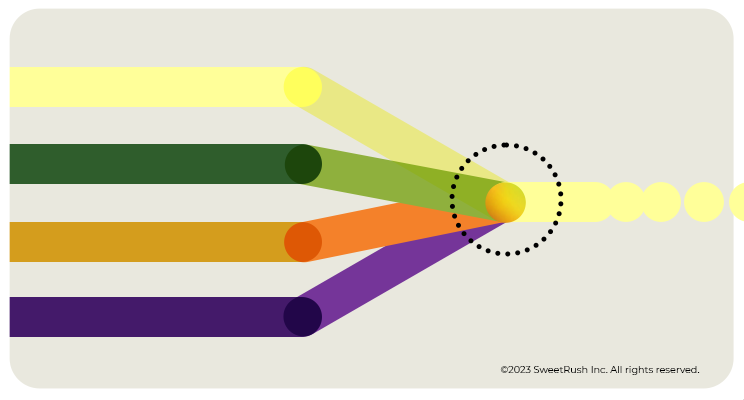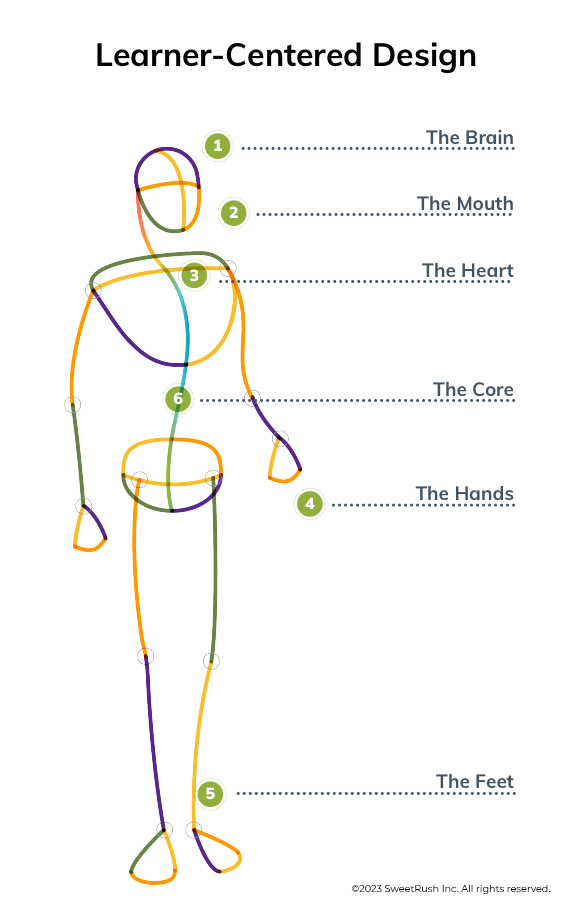L&D Trend Spotlight: SweetRush’s Learner-Centered Design Model

At SweetRush, we love learning and sharing knowledge.
Every year, we embark on a journey to bring you the top trends in learning and development (L&D) with our Learner Experience Trends Report. To create the report, we surveyed hundreds of L&D professionals, experts, and leaders to get a pulse on their insights, challenges, predictions, and lessons learned. Then, we analyze and compile the data and findings into a report with real-life examples and tips. And finally, we share it with you, giving you free and invaluable tools to help you in your role and at your organization.
This year’s Trend Report is L&D and Learner Experience: How L&D is elevating human potential in a time of rapid change, and inside we present the first iteration of our SweetRush Learner-Centered Design (LCD) Model, which we call the “body model.”
How Did We Create the SweetRush Learner-Centered Design Model?
LCD represents a coalescence of 20 years of SweetRush’s work with our clients creating learning experiences that set new standards for engagement. It’s a holistic view of learners that is grounded in empathy and a heightened awareness of human needs.
At the foundation of LCD is empathy for learners. At SweetRush, we continually seek to deepen our understanding of and connection to learners through empathy interviews and conversations, learner analytics, and data provided by our clients.
Our design recommendations stem from our understanding of what learners think and feel, what they do, what interests them, where they want to go, obstacles in their way, their learning preferences, and more.
This model is continuing to evolve, and our next iteration will include key attributes of LCD, techniques for achieving LCD, and ways to measure.
Learner-Centered Design Is Human-Centered Design
Using the human body as a model, we can explain the key principles of our LCD approach:
The Brain In this model, the brain represents the myriad ways learners take in information and process it through the lens of previous experiences, conditioning, and beliefs. With LCD, we seek to understand learners’ unique perspectives and create experiences that engage their senses and support mental model shifts. LCD uses best practices in user experience, aesthetic design, and user engagement to heighten their focus, engage their emotions, and give them control.
The Mouth  People gain proficiency by interacting with others (family, friends, teachers, coaches, supervisors, colleagues). Most jobs entail interaction with other people. LCD provides social learning opportunities—help, direction, feedback, conversation, and, generally, social engagement.
People gain proficiency by interacting with others (family, friends, teachers, coaches, supervisors, colleagues). Most jobs entail interaction with other people. LCD provides social learning opportunities—help, direction, feedback, conversation, and, generally, social engagement.
The Heart  People learn only when they want to learn, and they want to learn when it can help themselves, their families and friends, peers and teams, customers, and/or the world. LCD motivates learners via a strong WIIFM and by connecting learning to challenges learners face and aspirations they have for the future.
People learn only when they want to learn, and they want to learn when it can help themselves, their families and friends, peers and teams, customers, and/or the world. LCD motivates learners via a strong WIIFM and by connecting learning to challenges learners face and aspirations they have for the future.
The Hands  People naturally learn by doing. LCD provides opportunities to practice authentic tasks with feedback and reflection to achieve the desired outcome: skill development, behavior change, or both.
People naturally learn by doing. LCD provides opportunities to practice authentic tasks with feedback and reflection to achieve the desired outcome: skill development, behavior change, or both.
The Feet  People yearn for new challenges, reduction of suffering, better engagement with the world, greater fulfillment—and they vote with their feet when it’s time to move on. LCD provides guidance and support, so all learners can make progress on their goals, gain experience, advance in their careers, improve their way of doing and being, and get to better places.
People yearn for new challenges, reduction of suffering, better engagement with the world, greater fulfillment—and they vote with their feet when it’s time to move on. LCD provides guidance and support, so all learners can make progress on their goals, gain experience, advance in their careers, improve their way of doing and being, and get to better places.
The Core 
 LCD is an art and science, embracing the entire person and acknowledging the complexity of the whole. LCD centers on strong adult learning and user engagement principles, then expands to a holistic approach that leads to creative, innovative methods that bring rich and novel experiences to our learners.
LCD is an art and science, embracing the entire person and acknowledging the complexity of the whole. LCD centers on strong adult learning and user engagement principles, then expands to a holistic approach that leads to creative, innovative methods that bring rich and novel experiences to our learners.

The Levels of Learner-Centered Design: The Maturity Model
We asked our survey participants where they would rank themselves on the LCD model—Levels 1 through 4, as shown in the graphic below.
In Level 1, learning is one size fits all.
In Level 2, learners have some choice.
In Level 3, learning is an ongoing part of an employee’s experience.
And finally, in Level 4, learning is continuous, flexible, and adaptable.
Most respondents (35.8%) ranked themselves at Level 1, more than a quarter ranked themselves at Level 2 (26%), whereas 17.7% were at Level 3, and 20.4% were at Level 4 (the highest level).

As Clare Dygert—SweetRush Director of Learning Experience and Instructional Design—tells us, if you want effective skills-based learning, lean into the principles of Learner-Centered Design. Let your learners help guide you to the best experience for them. Center on the learner to effectively address your business needs and enhance the employee experience.
Read on to find out more about Learner-Centered Design, trends, challenges, and more, according to hundreds of Learning and Development professionals, experts, and leaders, across industries.
The post L&D Trend Spotlight: SweetRush’s Learner-Centered Design Model appeared first on SweetRush.







